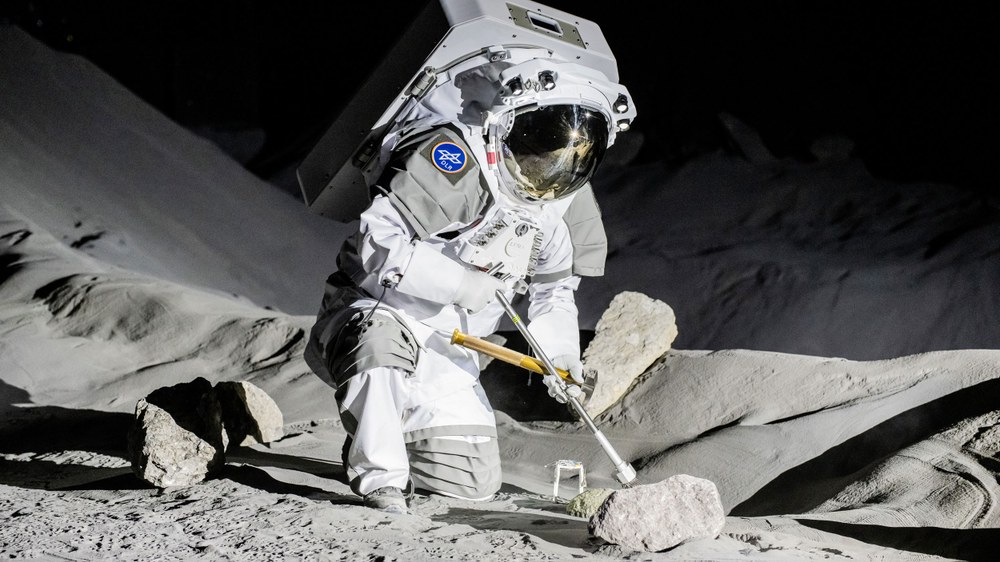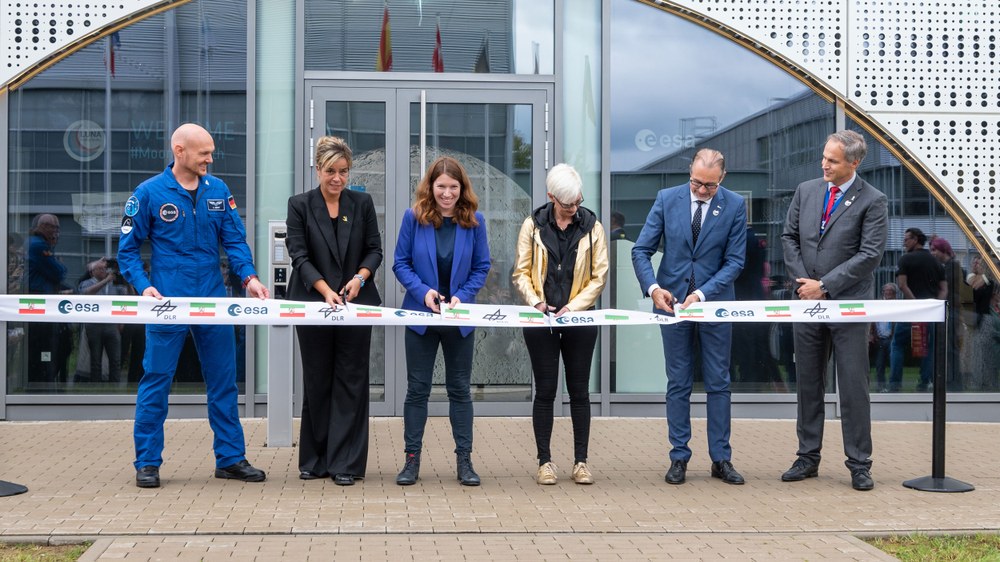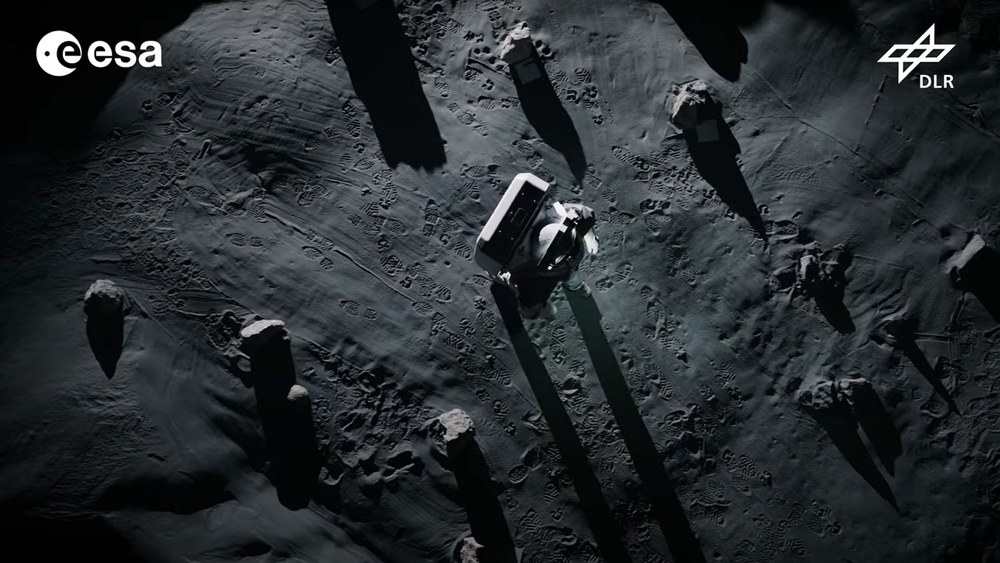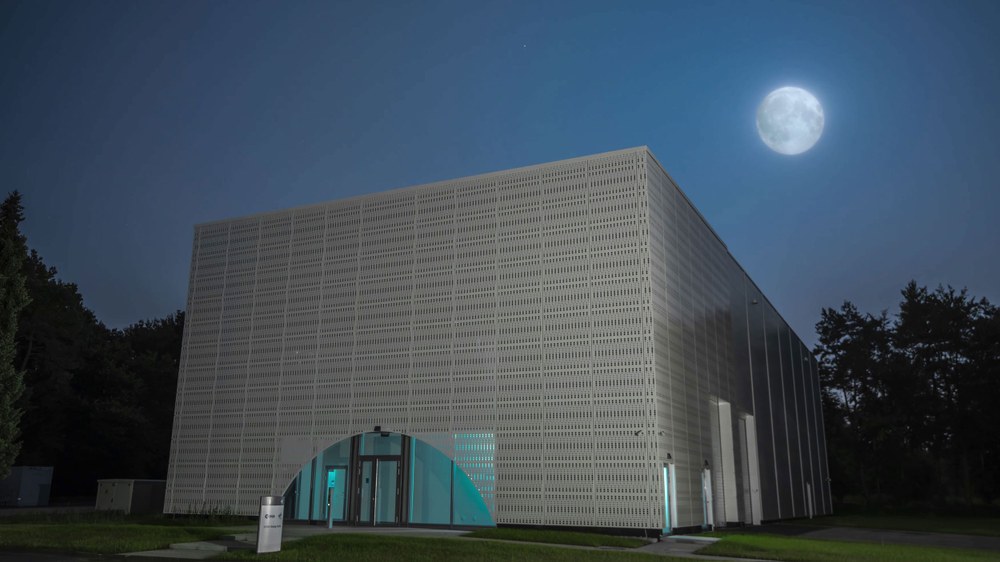Training facility for astronautical and robotic missions to the Moon


- The LUNA facility is designed to replicate conditions on the lunar surface.
- The research centre will prepare astronauts and robots for missions to the Moon.
- The joint DLR and ESA endeavour makes use of the space infrastructure and expertise available in the region and throughout Germany.
- Focus: Spaceflight, Moon, Exploration
The Moon now also exists on Earth – for the training of astronauts, the development of technologies and the preparation of long-term missions: The German Aerospace Center (Deutsches Zentrum für Luft- und Raumfahrt; DLR) and the European Space Agency ESA have now jointly established the LUNA research facility. The LUNA hall contains, among other things, a simulated lunar surface spanning an area of 700 square metres. It is filled with 'Moon dust', which is strikingly similar to actual lunar regolith. The rocks and boulders are modelled on lunar geology and a solar simulator recreates the lighting conditions on the Moon. The LUNA Hall was officially opened on 25 September 2024.
"LUNA will contribute to optimising our preparations for activities on the lunar surface through research into technologies and innovation for space exploration. This involves robotics as well as artificial intelligence, the utilisation of local resources and resource-conserving cycles all the way through to regenerative energy systems. LUNA provides a unique array of elements for scientific research and technological development under one roof. In its role as the 'Moon on Earth', LUNA will sustainably support activities on the Moon from Germany," says Anke Kaysser-Pyzalla, Chair of the DLR Executive Board.
Minister-President of the state of North Rhine-Westphalia Hendrik Wüst: "Now it's official: the road to the Moon runs through North Rhine-Westphalia. With the opening of the LUNA Analog Facility, Cologne is once again making space history. The globally unique training and technology centre shows how innovative research and international cooperation are pushing the boundaries of what is possible. North Rhine-Westphalia is thus strengthening its position as a prime location for aerospace and making a significant contribution to driving technological innovation."
ESA Director General Josef Aschbacher says, "The opening of LUNA marks a significant milestone in Europe’s space exploration efforts. This unique facility, with its ability to replicate lunar conditions, advances our understanding of the Moon and prepares us for future missions. We are proud to lead this project, which positions Europe at the forefront of lunar exploration and beyond, while also fostering international collaboration in space research."

Video: LUNA Analog Facility – The Moon on Earth
Your consent to the storage of data ('cookies') is required for the playback of this video on Youtube.com. You can view and change your current data storage settings at any time under privacy.
© DLR 2024
Mona Neubaur, Minister for Economic Affairs, Industry, Climate Action and Energy of the State of North Rhine Westphalia: "Straight to the Moon from North Rhine-Westphalia: LUNA, the only lunar simulation facility of its kind in Europe, will make Cologne a major hub for spaceflight. Europe together with international partners is currently planning projects on the Moon and in near-Earth space - and one of the routes into space now starts in Cologne. We are particularly proud of this fascinating research facility which, in addition to providing sustainable means of preparing astronauts and technology for the exploration of the Moon, also offers innovative opportunities for the efficient utilisation of energy and materials. Supporting the establishment of the facility with state funds was therefore a major priority for us."
Anna Christmann, Member of the German Bundestag and Federal Government Coordinator of German Aerospace Policy, emphasises: "The missions to the Moon are not only crucial for space exploration, but they also provide important insights that will help us address challenges and develop solutions on Earth: limited resources, climate change, public health in an ageing society and the restructuring of our energy and transport systems. With the LUNA Analog Facility in Cologne, we hold the key to the Moon in our hands and are paving the way for innovative and European lunar activities through the highly complex simulations it enables."
Solar simulator, hidden 'ice' and Moon dust from NRW
LUNA has a lot to offer: Most of the floor is covered with a 60-centimetre-thick layer of regolith. An area three metres below ground level, which can even be frozen, allows drilling techniques to be tested. In future, it will be possible to carry out tests on an inclined plane on an adjustable ramp. This will be important to determine whether astronauts or rovers will be able to move safely on inclined surfaces. The 'Gravity Offloading System' will soon simulate lunar gravity: To this end, trolleys and cable systems will be installed on the ceiling over the next few months so that astronauts or rovers are able to move as if they were on the moon weighing just one sixth of their actual weight. A number of artefacts are buried in the regolith, such as Plexiglas elements and a lava tube. The Plexiglas elements simulate water ice hidden beneath the surface of the moon, which can be explored using radar experiments.
The lava tube is a relevant localisation target for seismic experiments. The LUNA hall also includes a dust chamber in which protective measures against lunar dust can be investigated. The fine and sharp-edged regolith can cling to technological equipment and cause problems. The solar simulator is suitable for recreating the long, sharp, dark shadows cast in the polar regions of the Moon. The Moon's south pole is particularly interesting because it is thought to harbour water ice in its ever-shadowy craters. The LUNA facility will also be connected to the data networks of the German Space Operations Centre (GSOC) in Oberpfaffenhofen, to which the DLR Microgravity User Support Center (MUSC) and the European Astronaut Centre (EAC) are also linked.
In future, GSOC will also be home to the Human Exploration Control Center (HECC), the European control centre for the future Artemis moon missions, creating a unique ecosystem for lunar missions.
The LUNA hall is expected to reach full operational status by 2026. "LUNA will support the exploration of the Moon by providing astronauts and researchers with a realistic operational environment in which to train, test equipment and refine mission procedures. This will help ensure that the technologies and strategies to be used on the Moon are thoroughly tested and optimised beforehand," says Thomas Uhlig, DLR LUNA Project Manager.
The regolith simulant in the hall was made from basalt and originates from a quarry in the Rhein-Sieg district of North Rhine-Westphalia. In terms of its chemical, physical and geotechnical properties, the mixture is very similar to the regolith that the Apollo astronauts brought back to Earth from the Mares regions. These areas can be recognised as brighter areas on the lunar surface. There are currently approximately 750 tonnes of regolith simulant in the LUNA hall. This will increase to 900 tonnes as soon as the final construction work on the ramp and dust chamber has been completed. The ‘Moon dust’ was delivered over weeks in large sacks and distributed throughout the hall.
Prepared for extended missions to the Moon: Neighbouring greenhouse and lounge area
The LUNA infrastructure also supports longer-term lunar missions: The FLEXHab, a living and recreation area for astronaut training missions, will be located next to the hall in future. In addition, the EDEN LUNA greenhouse will be brought to Cologne. The greenhouse supplied employees at Neumayer Station III in Antarctica with fresh food during the EDEN ISS project between 2018 to 2022. EDEN LUNA will be located next to the LUNA hall in Cologne next year following a refurbishment.
History of the LUNA facility
The initial concept of a lunar facility was the result of a study that began in 2013. Over the years, the concept developed into a very sophisticated and versatile facility. In 2022, the state of North Rhine-Westphalia pledged funding of 25 million euros. Construction work began the following year. ESA is financing the construction of the hall, while DLR, with the support of the Ministry of Economic Affairs, Industry, Climate Action and Energy of the state of North Rhine-Westphalia, is providing the technical equipment for the hall and the integrated lunar technology centre. A large part of the infrastructure as well as preparation rooms, laboratories and visitor rooms are housed here.
The LUNA facility will be available to national and international research institutions, space agencies, universities and student groups, industrial companies and start-ups wishing to conduct experiments and test campaigns.
The LUNA facility is located on the DLR site in Cologne in the immediate vicinity of the European Astronaut Centre (EAC), :envihab of the DLR Institute of Aerospace Medicine, the DLR Institute of Materials Physics in Space and MUSC. The existing space infrastructure and the technical expertise of the ESA and DLR institutions in the region flow into the activities of the LUNA facility. In addition, LUNA is linked to space control centres around the world via GSOC.
The DLR institutes for Future Fuels, Materials Research, Robotics and Mechatronics, Space Systems and DLR's Space Operations and Astronaut Training are also involved. The German Space Agency at DLR is involved in LUNA through its contribution to the ESA Exploration Programme.
Related links
- LUNA Analog Facility website
- Image gallery LUNA – 'Moon on Earth' on Flickr
- DLR Blog "Lunar geology in the LUNA Hall: the road is getting rocky..."
- DLR Blog "A new lava tunnel and tonnes of regolith: There's dust in the LUNA hall!"
- DLR Blog "The Moon's terrestrial outpost - the LUNA facility"
- EDEN LUNA site
- EDEN ISS dedicated site

